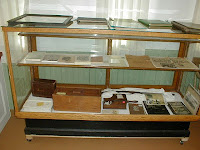With this in mind, I recently presented the following ideas to a local historical society in an effort to help them re-energize their exhibits. At the outset of our meeting, the Society president defined her goals. She aimed:
1. To make exhibits more interesting and interactive for a 21st century audience
2. To encourage increased visitation
3. To provide appropriate labeling in order to offer a context for historical subjects to which visitors can relate, connecting the past and the present
3. To ensure that artifacts are properly cared for and preserved
After an initial review of the institution, I suggested the following:
A. Focusing and rotating exhibits periodically will allow the Society to create more interesting displays and programs. It will also encourage visitors to return to see things they have never seen in the past.
B. Rotating exhibits will enable the Historical Society to better preserve materials. Displayed items (especially archival materials) are negatively impacted by light and other environmental factors. They are better protected in proper boxes and can be rotated out of secure storage for periodic viewing. Stored materials can be monitored and volunteers can work on preservation techniques while items are not on view.
C. Development of new exhibits will encourage more active community participation by highlighting areas for collection development and drawing out areas of interest. (I am a strong proponent of collection development policies with mission, vision and goals. These bring the purpose, value, and shared community interests of your Historical Society directly to your audience and can help encourage an active interest in the success of your institution.)
D. Updated exhibits will enable volunteers to more easily address issues of context through an emphasis on focused ideas (built around eras or themes) and more appropriate label copy. Focused brochures, interactive exhibit design, and updated programs can also be part of emphasizing context. Context is especially important in this modern era. It is valuable to connect our past to our present and future -- to show why history is valuable to each individual.
A. Focusing and rotating exhibits periodically will allow the Society to create more interesting displays and programs. It will also encourage visitors to return to see things they have never seen in the past.
B. Rotating exhibits will enable the Historical Society to better preserve materials. Displayed items (especially archival materials) are negatively impacted by light and other environmental factors. They are better protected in proper boxes and can be rotated out of secure storage for periodic viewing. Stored materials can be monitored and volunteers can work on preservation techniques while items are not on view.
C. Development of new exhibits will encourage more active community participation by highlighting areas for collection development and drawing out areas of interest. (I am a strong proponent of collection development policies with mission, vision and goals. These bring the purpose, value, and shared community interests of your Historical Society directly to your audience and can help encourage an active interest in the success of your institution.)
D. Updated exhibits will enable volunteers to more easily address issues of context through an emphasis on focused ideas (built around eras or themes) and more appropriate label copy. Focused brochures, interactive exhibit design, and updated programs can also be part of emphasizing context. Context is especially important in this modern era. It is valuable to connect our past to our present and future -- to show why history is valuable to each individual.
In order to accomplish these goals and activities I made some recommendations that would help the Society achieve success in steps while re-examining some basic administrative tasks. I will address these in a post next week.
***
***
Many articles in recent years have talked about re-conceptualizing the role of the historical organizations and the need for change. Here are a couple of creative ways to think about the "new" historical society that I have found very interesting:

No comments:
Post a Comment